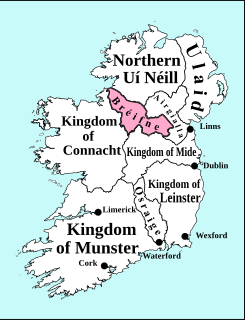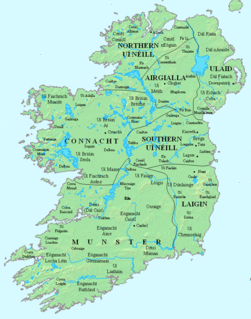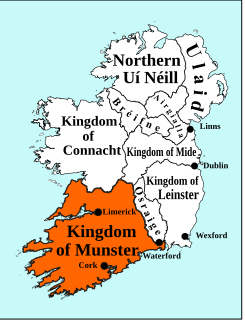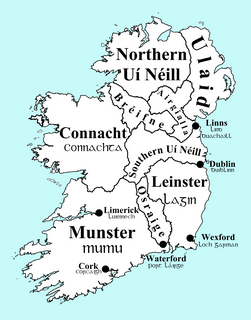 W
WAirgíalla was a medieval Irish over-kingdom and the collective name for the confederation of tribes that formed it. The confederation consisted of nine minor kingdoms, all independent of each other but paying nominal suzerainty to an overking, usually from the most powerful dynasty. Airgíalla at its peak roughly matched the modern dioceses of Armagh and Clogher, spanning parts of counties Armagh, Monaghan, Louth, Fermanagh, Tyrone and Londonderry. Its main towns were Armagh and Clogher. The name's usage survives as a cultural area of folk tradition in South East Ulster and adjoining areas of County Louth.
 W
WThe Kingdom of Breifne or Bréifne was a medieval overkingdom in Gaelic Ireland. It comprised what is now County Leitrim, County Cavan and parts of neighbouring counties, and corresponds roughly to the Roman Catholic Diocese of Kilmore. It had emerged by the 10th century, as a confederation of túatha headed by an overking drawn from the Uí Briúin Bréifne.
 W
WBetween the 5th and 12th centuries, an Irish sept claiming descent from Coirpre mac Néill ruled a barony of north Tethbae, called Cairpre Gabra. Their territory corresponds to the barony of Granard in modern county Longford in Ireland.
 W
WClandeboye or Clannaboy was a kingdom of Gaelic Ireland, comprising what is now south County Antrim, north County Down, and the barony of Loughinsholin, Northern Ireland. The entity was relatively late in appearance and is associated partly with the Gaelic resurgence of the High Middle Ages. The O'Neill Clandeboy who reigned in the territory descended from Hugh Boy O'Neill, a king of Tyrone. His descendants took advantage of the demise of the Earldom of Ulster during the latter 14th century and seized vast portions of territory. Clandeboye's main seats of power were Shane's Castle and Castle Reagh.
 W
WThe Corcu Duibne, which means "seed or tribe of Duibhne", was a notable kingdom in prehistoric and medieval County Kerry, Ireland which included the Dingle Peninsula, the Iveragh Peninsula and connecting lands. The tribe belonged to the Érainn and claimed descent from the legendary Conaire Mór, possibly making them distant cousins of such far off kingdoms as Dál Riata in Ulster and Scotland, as well as the closer Múscraige and Corcu Baiscind. All the tribes belonged to the Síl Conairi of legend and ultimately traced their descent from the Clanna Dedad.
 W
WDál Riata or Dál Riada was a Gaelic kingdom that encompassed the western seaboard of Scotland and the north-eastern corner of Ireland, on each side of the North Channel. At its height in the 6th and 7th centuries, it covered what is now Argyll in Scotland and part of County Antrim in Northern Ireland. After a period of expansion, Dál Riata eventually became associated with the Gaelic Kingdom of Alba.
 W
WThe Kingdom of Desmond was a historic kingdom in southwestern Ireland. It was founded in 1118 by king Tadhg Mac Cárthaigh, when the Treaty of Glanmire formally divided the Kingdom of Munster into Desmond and Thomond. It comprised all of what is now County Cork and most of County Kerry. Desmond was ruled by the Mac Cárthaigh (MacCarthy) dynasty. Other clans within the kingdom included the O'Sullivans and O'Donovans. Following the Norman invasion of Ireland in the late 12th century, the eastern half of Desmond was conquered by the Anglo-Normans and became the Earldom of Desmond, ruled by the FitzGeralds and Fitzmaurices. The king of Desmond, Diarmaid Mac Cárthaigh, submitted to Henry II of England, but the western half of Desmond lived on as a semi-independent Gaelic kingdom. It was often at war with the Anglo-Normans. Fínghin Mac Carthaigh's victory over the Anglo-Normans at the Battle of Callann (1261) helped preserve Desmond's independence. The kings of Desmond founded sites such as Blarney Castle, Ballycarbery Castle, Muckross Abbey and Kilcrea Friary. Following the Nine Years' War of the 1590s, Desmond became part of the Kingdom of Ireland.
 W
WVikings invaded the territory around Dublin in the 9th century, establishing the Norse Kingdom of Dublin, the earliest and longest-lasting Norse kingdom in Ireland. Its territory corresponded to most of present-day County Dublin. The Norse referred to the kingdom as Dyflin, which is derived from Irish Dubh Linn 'black pool'. The first reference to the Vikings comes from the Annals of Ulster and the first entry for 841 AD reads: "Pagans still on Lough Neagh". It is from this date onward that historians get references to ship fortresses or longphorts being established in Ireland. It may be safe to assume that the Vikings first over-wintered in 840–841 AD. The actual location of the longphort of Dublin is still a hotly debated issue. Norse rulers of Dublin were often co-kings, and occasionally also Kings of Jórvík in what is now Yorkshire. Under their rule, Dublin became the biggest slave port in Western Europe.
 W
WFermanagh was a kingdom of Gaelic Ireland, associated geographically with present-day County Fermanagh. Fir Manach originally referred to a distinct kin group of alleged Laigin origins. The kingdom of Fermanagh was formed in the 10th century, out of the larger kingdom of Uí Chremthainn, which was part of the overkingdom of Airgíalla. By the late 11th century it had grown to cover all of what is now County Fermanagh. The kingdom came to be ruled by the Mag Uidhir (Maguire) clan from the late 13th century onward. They were based at Lisnaskea, and their royal inauguration site was nearby Sgiath Gabhra (Skeagoura), now called Cornashee. Under Hugh Maguire, Fermanagh was involved in the Nine Years' War against English rule. His successor, Cú Chonnacht Óg Mag Uidhir, was one of the Gaelic Irish leaders who fled Ireland during the Flight of the Earls. Fermanagh was subsequently merged into the Kingdom of Ireland as County Fermanagh.
 W
WIveagh is the name of several historical territorial divisions in what is now County Down, Northern Ireland. Originally it was a Gaelic Irish territory, ruled by the Uí Echach Cobo and part of the overkingdom of Ulaid. From the 12th century the Magennises were chiefs of Iveagh. They were based at Rathfriland and were inaugurated at Knock Iveagh. Following the Nine Years' War, the rulers of Iveagh submitted to the English Crown and the territory was divided between them. Iveagh became a barony, which was later split into Iveagh Lower and Iveagh Upper. The territory of Iveagh was also the basis of the Roman Catholic Diocese of Dromore.
 W
WThe Kingdom of Munster was a kingdom of Gaelic Ireland which existed in the south-west of the island from at least the 1st century BC until 1118. According to traditional Irish history found in the Annals of the Four Masters, the kingdom originated as the territory of the Clanna Dedad, an Érainn tribe of Irish Gaels. Some of the early kings were prominent in the Red Branch Cycle such as Cú Roí and Conaire Mór. For a few centuries they were competitors for the High Kingship or Ireland, but ultimately lost out to the Connachta, descendants of Conn Cétchathach. The kingdom had different borders and internal divisions at different times during its history.
 W
WOsraige or Osraighe, Osraí, anglicized as Ossory, was a medieval Irish kingdom comprising what is now County Kilkenny and western County Laois, corresponding to the Diocese of Ossory. The home of the Osraige people, it existed from around the first century until the Norman invasion of Ireland in the 12th century. It was ruled by the Dál Birn dynasty, whose medieval descendants assumed the surname Mac Giolla Phádraig.
 W
WSíol Anmchadha was a sub-kingdom or lordship of Uí Maine, and ruled by an offshoot of the Uí Maine called the Síol Anmchadha, from whom the territory took its name.
 W
WTethbae was a confederation of túatha in central Ireland in the Middle Ages. It was divided into two distinct kingdoms, north Tethba, ruled by the Cenél Coirpri, and south Tethba, ruled by the Cenél Maini. It covered parts of County Westmeath and much of County Longford, counties which today are the far north-west part of the province of Leinster. In some cases Tethbae may refer to south Tethbae only.
 W
WThomond, also known as the kingdom of Limerick, was a kingdom of Gaelic Ireland, associated geographically with present-day County Clare and County Limerick, as well as parts of County Tipperary around Nenagh and its hinterland. The kingdom represented the core homeland of the Dál gCais people, although there were other Gaels in the area such as the Éile and Eóganachta, and even the Norse of Limerick. It existed from the collapse of the Kingdom of Munster in the 12th century as competition between the Ó Briain and the Mac Cárthaigh led to the schism between Thomond and Desmond. It continued to exist outside of the Anglo-Norman controlled Lordship of Ireland until the 16th century.
 W
WTír Eoghain, also known as Tyrone, was a kingdom and later earldom of Gaelic Ireland, comprising parts of present-day County Tyrone, County Armagh and County Londonderry. The kingdom represented the core homeland of the Cenél nEógain people of the Northern Uí Néill and although they ruled, there were smaller groups of other Gaels in the area. Also known as the guidance of Land. One part of the realm to the north-east broke away and expanded, becoming Clandeboye, ruled by a scion branch of the O'Neill dynasty.
 W
WTyrconnell, also spelled Tirconnell, was a kingdom of Gaelic Ireland, associated geographically with present-day County Donegal in Ulster, which has sometimes been called County Tyrconnell. At times it also included parts of County Fermanagh, County Sligo, County Leitrim, County Tyrone and County Londonderry at its greatest extent. The kingdom represented the core homeland of the Cenél Conaill people of the Northern Uí Néill and although they ruled, there were smaller groups of other Gaels in the area.
 W
WUí Díarmata was a local kingdom located in what is now north County Galway.
 W
WUí Fhiachrach Aidhne was a kingdom located in what is now the south of County Galway.
 W
WThe Uí Liatháin were an early kingdom of Munster in southern Ireland. They belonged the same kindred as the Uí Fidgenti, and the two are considered together in the earliest sources, for example The Expulsion of the Déisi (incidentally). The two have been given various origins among both the early or proto-Eóganachta and among the Érainn or Dáirine by different scholars working in a number of traditions, with no agreement ever reached or appearing reachable. It is entirely possible that they were the product of a combination of lineages from both these royal kindreds, or alternatively of another origin entirely.
 W
WUí Mháine, often Anglicised as Hy Many, was one of the oldest and largest kingdoms located in Connacht, Ireland. Its territory of approximately 1,000 square miles (2,600 km2) encompassed all of what is now north, east and south County Galway, south and central County Roscommon, an area near County Clare, and at one stage had apparently subjugated land on the east bank of the Shannon, together with the parish of Lusmagh in Offaly.
 W
WUlaid, or Ulaidh, was a Gaelic over-kingdom in north-eastern Ireland during the Middle Ages made up of a confederation of dynastic groups. Alternative names include Ulidia, which is the Latin form of Ulaid, and in Cóiced, Irish for "the Fifth". The king of Ulaid was called the rí Ulad or rí in Chóicid.
 W
WUmaill was a territory located in the west of what is now County Mayo, Ireland. It comprises the baronies of Burrishoole and Murrisk, essentially all the land adjacent to Clew Bay.